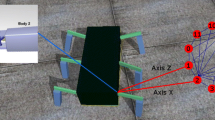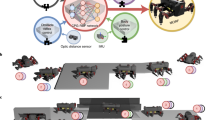Abstract
As a prerequisite for developing neural control for walking machines that are able to autonomously navigate through rough terrain, artificial structure evolution is used to generate various single leg controllers. The structure and dynamical properties of the evolved (recurrent) neural networks are then analysed to identify elementary mechanisms of sensor-driven walking behaviour. Based on the biological understanding that legged locomotion implies a highly decentralised and modular control, neuromodules for single, morphological distinct legs of a hexapod walking machine were developed by using a physical simulation. Each of the legs has three degrees of freedom (DOF). The presented results demonstrate how extremely small reflex-oscillators, which inherently rely on the sensorimotor loop and e.g. hysteresis effects, generate effective locomotion. Varying the fitness function by randomly changing the environmental conditions during evolution, neural control mechanisms are identified which allow for robust and adaptive locomotion. Relations to biological findings are discussed.
Similar content being viewed by others
Abbreviations
- AEP:
-
Anterior extreme position
- CPG:
-
Central pattern generator
- CT:
-
Coxa-trochanter
- DOF:
-
Degrees of freedom
- FL:
-
Fore-leg
- FT:
-
Femur-tibia
- HL:
-
Hind-leg
- ML:
-
Middle-leg
- PEP:
-
Posterior extreme position
- TC:
-
Thorax-coxa
References
Bässler U, Büschges A (1998) Pattern generation for stick insect walking movements – multisensory control of a locomotor program. Brain Research Reviews 27:65–88
Beer R, Gallagher J (1992) Evolving dynamical neural networks for adaptive behavior. Adaptive Behavior 1:91–122
Brooks RA (1989) A Robot that Walks: Emergent Behaviors from a Carefully Evolved Network. Technical Report AI MEMO 1091, MIT
Brooks RA (1991) Intelligence without representation. Artificial Intelligence 47:139–159
Buddenbrock Wv (1921) Der Rhythmus der Schreitbewegungen der Stabheuschrecke Dyxippus. Biologisches Zentralblatt 41:41–48
Büschges A (2005) Sensory control and organization of neural networks mediating coordination of multisegmental organs for locomotion. Journal of Neurophysiology 93:1127–1135
Büschges A, Schmitz J, Bässler U (1995) Rhythmic patterns in the thoracic nerve cord of the stick insect induced by pilocarpine. Journal of Experimental Biology 198:435–456
Chiel H, Beer R (1997) The brain has a body: adaptive behavior emerges from interactions of nervous system, body and environment. Trends in Neurosciences 20:553–557
Cruse H (1990) What mechanisms coordinate leg movement in walking arthropods? Trends in Neurosciences 13:15–21
Cruse H (2002) The functional sense of central oscillations in walking. Biological Cybernetics 86:271–280
Cruse H, Bartling C (1995) Movement of joint angles in the legs of a walking insect, Carausius morosus. Journal of Insect Physiology 41(9):761–771
Dean J (1998) Animats and what they can tell us. Trends in Cognitive Science 2(2):60–67
Dean J, Kindermann T, Schmitz J, Schumm M, Cruse H (1999) Control of walking in the stick insect: from behavior and physiology to modeling. Autonomous Robots 7:271–288
Delcomyn F (1999) walking robots and the central and peripheral control of locomotion in insects. Autonomous Robots 7:259–270
Dickinson MH, Farley CT, Full RJ, Koehl MAR, Kram R, Lehmann S (2000) How animals move: an integrative view. Science 288:100–106
Dumont JPC, Robertson RM (1986) Neuronal circuits: an evolutionary perspective. Science 233:849–853
Ekeberg O, Blümel M, Büsschges A (2004) Dynamic simulation of insect walking. Arthropod Structure & Development 33:287–300
Ferrell C (1995) A comparison of three insect inspired locomotion controllers. Robotics and Autonomous Systems 16:135–159
Full RJ (1997) Invertebrate locomotor systems. In: Dantzler W (ed) The Handbook of Comparative Physiology, pp. 853–930. Oxford University Press
Grillner S, Ekeberg O, Manira AE, Lansner A, Parker D, Tegner J, Wallen P (1998) Intrinsic function of a neuronal network – a vertebrate central pattern generator. Brain Research Reviews 26(2–3):184–197
Hatsopoulos NG, Burrows M, Laurent G (1995) Hysteresis reduction in proprioception using presynaptic shunting inhibition. Journal of Neurophysiology 73(3):1031–1042
Heinzel H-G, Weimann JM, Marder E (1993) The behavioral repertoire of the gastric mill in the crab, cancer pagurus: an in situ endoscopic and electrophysiological examination. The Journal of Neuroscience 13(4):1793–1803
Hülse M, Wischmann S, Pasemann F (2004) Structure and function of evolved neuro-controllers for autonomous robots. Connection Science 16(4):294–266
Jacob D, Polani D and Nehaniv CL (2005) Legs that can walk: embodiment-based modular reinforcement learning applied. In: IEEE Computational Intelligence in Robotics & Automata (IEEE CIRA 2005). pp 365–372
Jindrich DL, Full RJ (2002) Dynamic stabilization of rapid hexapedal locomotion. Journal of Experimental Biology 205:2803–2823
Kononenko NI, Dudek FE (2006) Persistent calcium current in rat suprachiasmatic nucleus neurons. Neuroscience 138:377–388
Kostyukov AI (1998) Muscle hysteresis and movement control: a theoretical study. Neuroscience 83(1):303–320
Lee RH, Heckman CJ (1998) Bistability in spinal motoneurons in vivo: systematic variations in persistent inward currents. Journal of Neurophysiology 80:583–593
Linder CR (2005) Embodiment in two dimensions. In: Proceedings of the 7th International Conference on Climbing and Walking Robots 2004
Nolfi S, Floreano D (2000) Evolutionary robotics: the biology, intelligence, and technology of self-organizing machines. MIT Press, Cambridge, MA
Orlovsky G, Deliagina T and Grillner S (1999) Neuronal Control of Locomotion. Oxford University Press
Pasemann F (1993) Dynamics of a single model neuron. International Journal of Bifurcation and Chaos 2:271–278
Pasemann F (2002) Complex dynamics and the structure of small neural networks. Network: Computation in neural systems 13:195–216
Pasemann F, Hild M and Zahedi K (2003) SO(2)-networks as neural oscillators. In: Mira J and Alvarez J (eds) Computational Methods in Neural Modeling, pp. 144–151. Springer, Berlin
Pearson KG, Franklin R (1984) Characteristics of leg movements and patterns of coordination in locusts walking on rough terrain. International Journal of Robotics Research 3(2):101–112
Prochazka A, Gillard D, Bennett DJ (1997) Implications of positive feedback in the control of movement. The Journal of Neurophysiology 77(6):3237–3251
Psujek S, Ames J, Beer R (2006) Connection and coordination: the interplay between architecture and dynamics in evolved model pattern generators. Neural Computation 18:729–747
Quinn RD, Nelson GM, Bachmann RJ, Kingsley DA, Offi JT, Allen TJ, Ritzmann RE (2003) Parallel complementary strategies for implementing biological principles into mobile robots. International Journal of Robotics Research 22(3):169–186
Schmitz J, Dean J, Kindermann T, Schumm M, Cruse H (2001) A biologically inspired controller for hexapod walking: simple solutions by exploiting physical properties. The Biological Bulletin 200:195–200
Selverston AI, Panchin YV, Arshavsky YI, Orlovsky GN (1999) Neurons, Networks, and Motor Behavior, Chapt. Shared Features of Invertebrate Central Pattern Generators. MIT Press, Cambridge, MA, pp. 105–117
Toth TI, Hughes SW, Crunelli V (1998) Analysis and biophysical interpretation of bistable behaviour in thalamocortical neurons. Neuroscience 87(2):519–523
Wendler G (1966) The co-ordination of walking movements in arthropods. Symposia of the Society for Experimental Biology 20:229–249
Zill SN and Jepson-Innes K (1988) Evolutionary adaptation of a reflex system: sensory hysteresis counters muscle ‘catch’ tension. Journal of Comparative Physiology A 164:43–48
Acknowledgements
The authors would like to thank Martin Hülse, Steffen Wischmann and Keyan Zahedi for providing the evolution environment ISEE, Manfred Hild, Niko Kladt and Hans-Georg Heinzel for carefully reading and commenting on an earlier draft of this paper and an anonymous reviewer for valuable comments.
Author information
Authors and Affiliations
Corresponding author
Rights and permissions
About this article
Cite this article
von Twickel, A., Pasemann, F. Reflex-oscillations in evolved single leg neurocontrollers for walking machines. Nat Comput 6, 311–337 (2007). https://doi.org/10.1007/s11047-006-9011-y
Received:
Accepted:
Published:
Issue Date:
DOI: https://doi.org/10.1007/s11047-006-9011-y




